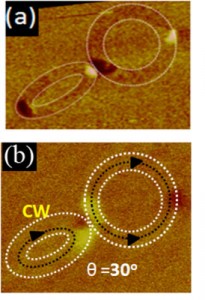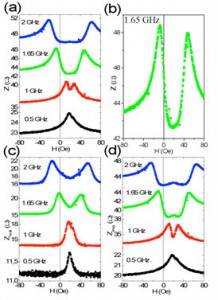Magnetic and Magnetoelectronic Memory and Logic
We are investigating the fabrication and magnetic properties of magnetic logic and memory devices. These consist of multilayer magnetoresistive ring-shaped structures as shown in Figure 1. The magnetic multilayers show giant magnetoresistance, in which the resistance is a function of the relative orientation of the magnetization directions in the magnetic layers. These small structures have potential uses in magnetic-random-access memories (MRAM), magnetic logic devices, and other magneto-electronic applications. Unlike that of conventional MRAM devices, the ring-shaped geometry of these devices allows for a complex response with multiple stable resistance states. This capability can be used for multi-bit memory and for programmable, non-volatile memory.
These devices are programmed using either a magnetic field or a current. We have also shown that spin-polarized currents can reverse the devices in a low-power process. We are currently investigating concatenation of multiple devices through stray field interactions and control of the behavior of individual devices through interlayer magnetostatic pinning interactions and manipulation of 360° domain walls with a spin-polarized current.
Simultaneously, we are exploring high-frequency behavior of magnetic nanostructures through giant magnetoimpedance. In GMI, the impedance of nanoscale structures varies dramatically with magnetic field and with frequency in the GHz range, and this variation can be used for sensitive magnetic field detection.
- Figure 1: Magnetic force micrograph showing a pair of ring devices. Domain walls are visible as black and white highlights. Interactions between these domain walls allow one ring to select between two isoenergetic vortex states in the other ring in an otherwise stochastic reversal process. The different chiralities of the vortex state may be used to encode data.
- Figure 2: Impedance measurements on an exchange-biased magnetic strip as a function of magnetic field at 0.5, 1, 1.65, and 2.0 GHz. (a) impedance, (b) magnified view of impedance at 1.65 GHz, (c) real part of the impedance, and (d) imaginary part of the impedance.
References
- C. Nam, M.D. Mascaro, and C.A. Ross, “Magnetostatic control of vortex chirality in Co thin film rings,” in preparation.
- C. García, J.M. Florez, P. Vargas, and C.A. Ross.. “Asymmetrical giant magnetoresistance in exchange-biased NiFe,” Appl. Phys. Lett. (accepted, in production)

